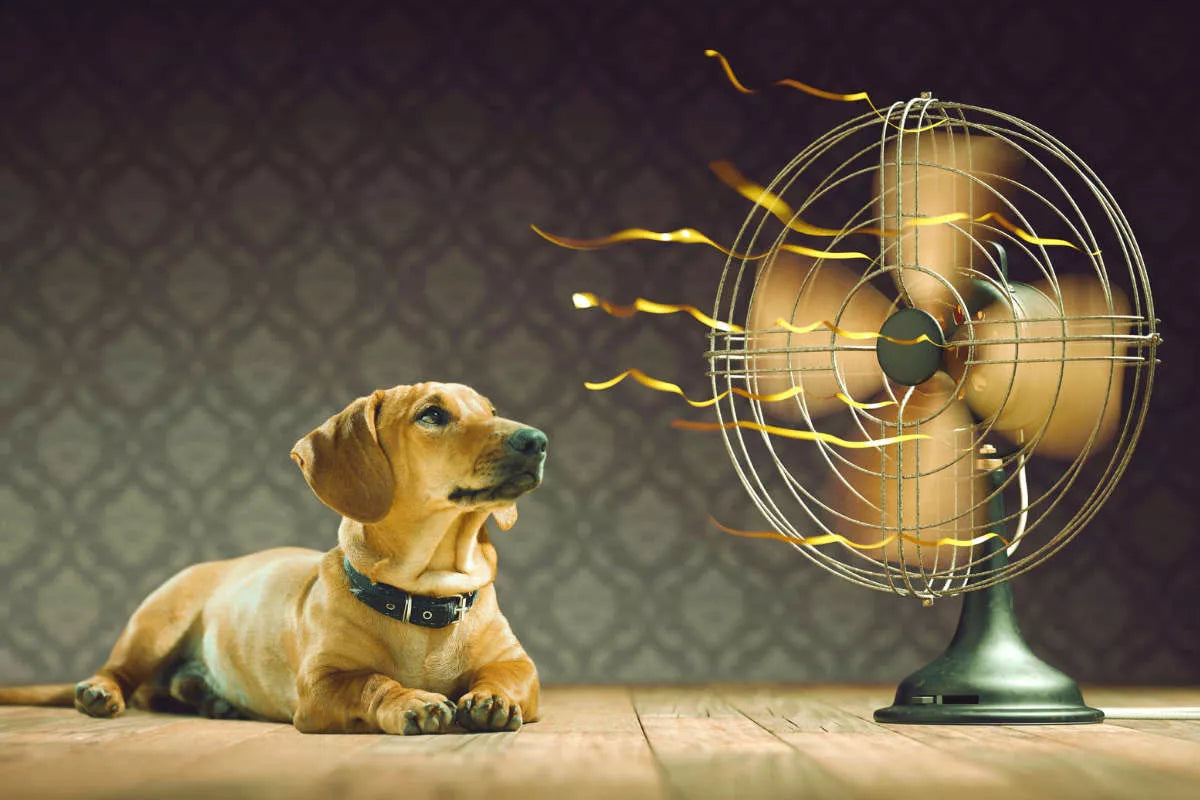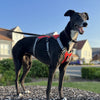How To Keep Your Dog Cool In The Summer

Summer should be a wonderful time for you and your dog. Long hot days and plenty of sunshine, what could be better? However, unlike you, your dog cannot take off items of clothing, go to the refrigerator for a cold drink or turn up the air-conditioning, if they get too warm. This can potentially make the summer a very uncomfortable, not to say dangerous, time of the year for your canine companion. Overheating and even heat stroke are distinct possibilities, unless you take the right care of your dog during the summer months.
We have all read about the unthinking owners who leave their dogs in their cars in hot weather, with disastrous consequences. This is just a stupid thing to do, yet there are many less obvious ways that your dog can suffer discomfort and even do serious damage to themselves in summer. And this can happen faster than you might imagine, so it’s good to be aware of exactly how your dog copes with hot weather, and how you can assist them to stay one very cool dog.
The bottom line here is that senior veterinarians do not recommend that owners shave double-coated breeds of dogs. Shaving removes the insulating layer of fur and can actually make your dog more susceptible to heat stroke. It can also cause follicle damage and improper hair growth.
Your dog can also lose heat by the expansion of blood vessels, especially in the face and ears, but the most important way your dog loses heat is by panting. When a dog pants they move air over moist parts of their bodies. This includes the linings of the lungs and the nose and of course their tongues - they lose heat by evaporation that way. It’s a method that worked very effectively for dogs in nature, however artificial selection by people to produce breeds like pugs, bulldogs and boxers has meant that problems with breathing can also cause problems with panting and hence with heat control.
Dogs will actively seek shade in the summer, especially nice damp patches – not always possible if they are in a house most of the day! In fact, by throwing their lot in with people, and their controlled environments, dogs have caused themselves quite a few summer-related problems. This does not mean that we cannot help them of course. Here are some useful guidelines for taking care of your dog in summer.
We all know how important it is for your dog to always have access to plenty of cool, clean water, but remember you might need to put extra down in the summer. The amount of water a dog drinks varies with their size, but it also varies with the time of year – and their diet too! Unless there are specific medical conditions it is never a good idea to regulate your dog’s water intake. This is even more important in the summer. Let them drink their fill.
2) Exercise
At the hottest times of the year you may need to walk your dog at the cooler times of the day. This could be first thing in the morning or later in the evening. If you are obliged to take them out during the hotter hours, make the exercise short but sweet. This means not too much running and always have that bowl of water ready and waiting for them when they come home. You can always take some water with you too if needs be. And when you’re out try to find a nice running surface for their paws. Concrete, sand or asphalt can get very hot in the summer, and you don’t want to burn or blister your dog’s feet.
Swimming can be a great way for your dog to get exercise, and cool down. However, just like people – some dogs are better swimmers than others are. Also be careful when near rivers, getting into the water can be easy for a dog, getting out can be more problematic. Certainly a garden sprinkler or a child’s paddling pool can be a safer summer doggie treat.
3) When at home
Try to position your dog’s bed in a cool part of the house, preferably out of the sun, with some ventilation. A utility room is often ideal – they won’t mind any old laundry hanging around. Beware of conservatories, they can get ridiculously hot in the summer. It is probably best to not even allow your dog access, just in case they become shut in. To assist your dog further, especially useful for larger dogs, there are dog-cooling mats. These do not have to be kept in the freezer or be plugged in to work, the most effective operate with what are called phase-change materials. These materials are non-toxic and help to effectively remove heat from your dog for several hours. They can then be recharged by simply putting them in a cool, dark room overnight, or by popping in the fridge for twenty minutes or so. Whatever you do, don’t be tempted to buy or use ice packs to cool your dog down. There is a real danger that you could shock your dog in this way and cause it harm. However, the PCM mats are safe and can also be taken in the car on a journey. But just to reiterate: this is for when you are on the move, never ever leave your dog unattended in a hot car in the summer.
4) In the garden
It’s great to be able to give your dog access to the garden in summer, but you need to make sure that they can either get back easily into the house or that they have a properly shady place to nap in the garden. And it goes without saying that there should be plenty of water, outside as well as inside.
Young puppies are also vulnerable and extra care might be required in the heat with very young dogs too. Also, as mentioned, breeds with short flat faces are more likely to have breathing problems, and hence panting and cooling problems. Dogs with certain diseases or on some types of medication are also more at risk.
If, on a hot summer’s day, your dog starts to exhibit excessive drooling and panting, appears lethargic, drowsy or uncoordinated, then they may be suffering from heat stroke. If they collapse or start vomiting it’s possible that they are in a very bad way indeed.
For the best chance of survival, dogs suffering from heat stroke urgently need to have their body temperature lowered – but not in a way that might send them into shock. So, immediately move a suffering dog into a cool, shady spot and pour cool – but not freezing – water over them. If possible, place cool, wet towels over them too and position them near a fan. Continue with these measures until you notice that their breathing has become more normal. But be careful, you do not want them to start shivering, as that will only stress them further. When they are able, it is a good idea to have them checked out by your vet. They can look for any more serious problems or damage.
First and foremost, do enjoy the summer with your dog. It’s a great time for some splendid walks and great socialisation with other dogs, and their owners. Just take sensible precautions and remember, as much as you love your pet, they are a different animal and, as such, they will function and behave differently. That’s all part of the fun after all.
Wiggles and Wags offer high quality PCM pet cooling mats which are designed to cool your dog through phase change cooling processes. These are safe and efficient.
We have all read about the unthinking owners who leave their dogs in their cars in hot weather, with disastrous consequences. This is just a stupid thing to do, yet there are many less obvious ways that your dog can suffer discomfort and even do serious damage to themselves in summer. And this can happen faster than you might imagine, so it’s good to be aware of exactly how your dog copes with hot weather, and how you can assist them to stay one very cool dog.
Do Dogs Sweat?
It’s a popular fallacy that dogs don’t sweat – they do, just not like their owners. Dogs sweat through their paws. You might even see damp doggy paw prints on cool tiles in the summer. Sweating though is of far less significance to a dog than in humans. There would not be much point in sweating when you are covered in a fur coat. In people, sweat cools the body by removing heat through evaporation from the skin. A big fur coat means no evaporation can take place.Should I Shave My Dogs Fur In The Summer?
However, this does not mean that a dog’s fur is just about keeping it warm. Fur actually insulates, which means that it can trap warm air in the winter to keep your dog warm, but it will also trap cool air in the summer to help keep your dog cool. This is particularly the case with double-coated breeds like Golden Retrievers, Chows, Border Collies, German Shepherds, Huskies, Newfoundlands and Pomeranians. These breeds all have a dense undercoat full of short hairs, typically with a woolly texture.The bottom line here is that senior veterinarians do not recommend that owners shave double-coated breeds of dogs. Shaving removes the insulating layer of fur and can actually make your dog more susceptible to heat stroke. It can also cause follicle damage and improper hair growth.
Your dog can also lose heat by the expansion of blood vessels, especially in the face and ears, but the most important way your dog loses heat is by panting. When a dog pants they move air over moist parts of their bodies. This includes the linings of the lungs and the nose and of course their tongues - they lose heat by evaporation that way. It’s a method that worked very effectively for dogs in nature, however artificial selection by people to produce breeds like pugs, bulldogs and boxers has meant that problems with breathing can also cause problems with panting and hence with heat control.
Dogs will actively seek shade in the summer, especially nice damp patches – not always possible if they are in a house most of the day! In fact, by throwing their lot in with people, and their controlled environments, dogs have caused themselves quite a few summer-related problems. This does not mean that we cannot help them of course. Here are some useful guidelines for taking care of your dog in summer.
Guidelines for dog care in summer
1) HydrationWe all know how important it is for your dog to always have access to plenty of cool, clean water, but remember you might need to put extra down in the summer. The amount of water a dog drinks varies with their size, but it also varies with the time of year – and their diet too! Unless there are specific medical conditions it is never a good idea to regulate your dog’s water intake. This is even more important in the summer. Let them drink their fill.
2) Exercise
At the hottest times of the year you may need to walk your dog at the cooler times of the day. This could be first thing in the morning or later in the evening. If you are obliged to take them out during the hotter hours, make the exercise short but sweet. This means not too much running and always have that bowl of water ready and waiting for them when they come home. You can always take some water with you too if needs be. And when you’re out try to find a nice running surface for their paws. Concrete, sand or asphalt can get very hot in the summer, and you don’t want to burn or blister your dog’s feet.
Swimming can be a great way for your dog to get exercise, and cool down. However, just like people – some dogs are better swimmers than others are. Also be careful when near rivers, getting into the water can be easy for a dog, getting out can be more problematic. Certainly a garden sprinkler or a child’s paddling pool can be a safer summer doggie treat.
3) When at home
Try to position your dog’s bed in a cool part of the house, preferably out of the sun, with some ventilation. A utility room is often ideal – they won’t mind any old laundry hanging around. Beware of conservatories, they can get ridiculously hot in the summer. It is probably best to not even allow your dog access, just in case they become shut in. To assist your dog further, especially useful for larger dogs, there are dog-cooling mats. These do not have to be kept in the freezer or be plugged in to work, the most effective operate with what are called phase-change materials. These materials are non-toxic and help to effectively remove heat from your dog for several hours. They can then be recharged by simply putting them in a cool, dark room overnight, or by popping in the fridge for twenty minutes or so. Whatever you do, don’t be tempted to buy or use ice packs to cool your dog down. There is a real danger that you could shock your dog in this way and cause it harm. However, the PCM mats are safe and can also be taken in the car on a journey. But just to reiterate: this is for when you are on the move, never ever leave your dog unattended in a hot car in the summer.
4) In the garden
It’s great to be able to give your dog access to the garden in summer, but you need to make sure that they can either get back easily into the house or that they have a properly shady place to nap in the garden. And it goes without saying that there should be plenty of water, outside as well as inside.
What to do if your dog gets heat stroke.
Heat stroke can happen, even when you’re taking extra care. Do remember that your dog may not be as young as they used to be and older dogs are more prone to heat stroke. Your dog may not be aware that life is moving on either and they can easily overdo things if not monitored on a hot day.Young puppies are also vulnerable and extra care might be required in the heat with very young dogs too. Also, as mentioned, breeds with short flat faces are more likely to have breathing problems, and hence panting and cooling problems. Dogs with certain diseases or on some types of medication are also more at risk.
If, on a hot summer’s day, your dog starts to exhibit excessive drooling and panting, appears lethargic, drowsy or uncoordinated, then they may be suffering from heat stroke. If they collapse or start vomiting it’s possible that they are in a very bad way indeed.
For the best chance of survival, dogs suffering from heat stroke urgently need to have their body temperature lowered – but not in a way that might send them into shock. So, immediately move a suffering dog into a cool, shady spot and pour cool – but not freezing – water over them. If possible, place cool, wet towels over them too and position them near a fan. Continue with these measures until you notice that their breathing has become more normal. But be careful, you do not want them to start shivering, as that will only stress them further. When they are able, it is a good idea to have them checked out by your vet. They can look for any more serious problems or damage.
First and foremost, do enjoy the summer with your dog. It’s a great time for some splendid walks and great socialisation with other dogs, and their owners. Just take sensible precautions and remember, as much as you love your pet, they are a different animal and, as such, they will function and behave differently. That’s all part of the fun after all.
Wiggles and Wags offer high quality PCM pet cooling mats which are designed to cool your dog through phase change cooling processes. These are safe and efficient.





